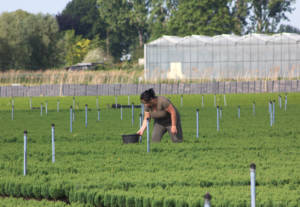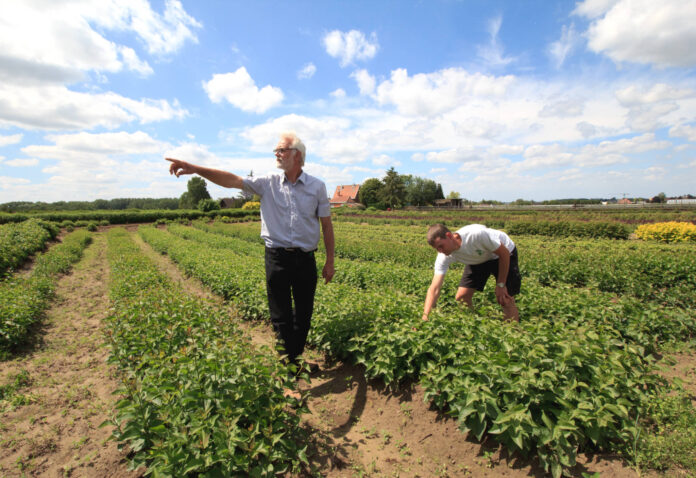At its annual conference, held as a zoom meeting in Ghent on 14 December 2021, the Belgian board for ornamentals growers, florists and landscapers (AVBS) raises awareness about mental health concerns, inspiring action on the part of all industry professionals to promote good health for all.
The conference theme was ‘Gek van Groen’ (Crazy about Greenery)’, a positively and negatively charged sentiment.
The good and the bad
People have been going greener since the global health crisis hit. Belgium’s thriving horticultural industry has enjoyed seeing more consumers gravitate towards gardens, trees, shrubs, houseplants, and cut flowers.
But Covid-19 has also taken its toll on growers during the 2021 financial year. The AVBS president Filip Goossens says, “At times, the pressure from outside the business has been heavy. Labour shortages have been an ongoing issue and have grown worse for several reasons. Poland’s prosperity is rising, while the Covid-19 pandemic provoked an exodus of seasonal migrant workers. The AVBS has entered a final round of talks with the government and trade unions to update and improve the country’s seasonal agricultural worker scheme. The goal is to allow foreign workers to come to Belgium for up to six months to work in horticulture and to improve pay and conditions, with hopefully not too much cost for our industry.”

The AVBS has entered a final round of talks with the government and trade unions to update and improve the country’s seasonal agricultural worker scheme.
Shortage of skilled labour
Goossens estimates that 90 per cent of the 49,000 seasonal workers in ornamental horticulture in Belgium are emigrants from the EU. He says, “Despite technological advances and more widespread automation, ornamental horticulture remains labour intensive. A shortage of skilled labour negatively impacts the efficiency and profitability of our sector. Within AVBS, we are lucky enough to have Chris Botterman, who has moved heaven and earth from the onset of the pandemic to keep our sector open. One of the major achievements of Botterman and his team was that the government deemed the sector essential, which guaranteed the continuity.”
Rising commodity prices
After reaping the benefits from exceptionally strong demand for flowers and plants, one of the biggest challenges ornamental horticulture in Belgium faces is the rising prices of many commodities, including crop protection products, fertilisers, peat, plastics and energy.
Goossens asked himself how long favourable prices will compensate for increased operating costs this winter. “It is regrettable to see that price hikes across the board cause profit margins to melt away. This situation will prompt all horticultural entrepreneurs to keep an eagle eye on costs.”
The mental and emotional toll

Nursery stock is one of the engines behind Flemish horticulture, occupying 83.8 per cent of the total acreage and 64 per cent of the production value.
Deputy president of Belgium’s farmer’s union Boerenbond Georges Van Keerberghen, mentioned the mental and emotional toll entrepreneurship can have—especially now that the sector faces unique and unfamiliar challenges. Van Keerberghen says, “Things like uncertainty about the future, societal and environmental issues plus red tape can all affect a grower’s mental health. A minor error in your company’s administration can have huge consequences and create much stress.”
Van Keerberghen notes that mental health in the sector is among AVBS’s priorities. And today, the trade organisation offers support through the Resilient Entrepreneur Course to cope with stress and pressure. When things risk getting out of control, entrepreneurs no longer know how to accomplish their tasks and what direction to choose AVBS offers the At Though Crossroads of Life counselling. Keerbergen concluded that it all boils down to communication, urging entrepreneurs with mental distress to be open.
In acknowledging uncertainties and offering encouragement, Van Keerbergen says the role of women behind horticultural companies is incredibly important. He says, “Women tend to find social interaction more important than men, discussing personal problems more commonly and with more ease.”
An eventful year lies ahead
Finally, Goossens sees an eventful year ahead with AVBS celebrating its golden jubilee, the reopening of the Floralies of Ghent flower show that was cancelled in 2020 and 2021; this year will open between 29 April and 8 May 2022. Then, there is the AIPH-approved world horticultural expo Floriade, in neighbouring the Netherlands, where Belgium will host a country pavilion.
Ornamental horticulture in Belgium: The Essentials

Flemish companies are world leaders in the production of Azaleas, with production concentrated in East Flanders around the city of Ghent. The Floralies of Ghent – the Ghent Flower Show – opens on 29 April 2022.
In 2020, Belgium’s ornamentals sector solidified its position as one of Europe’s top suppliers of ornamental horticulture products. Growers exported plants worth €564 million. The bulk of these exports are commercial young plants, seeds, shrubs, trees and tubers. Belgium’s core export market for ornamentals is France, accounting for 50 per cent of exports, worth €232 million. There is also interest from The Netherlands, the UK, and Germany accounting for €177 million (31.5 per cent), €55 million (9.6 per cent), and €22.5 million (4 per cent) in export sales, respectively.
Located in the heart of Western Europe, Belgium enjoys a long tradition of producing trees, shrubs, perennials, houseplants, bedding plants, seeds with tuberous Begonias, Azaleas and bay trees dominating an export-driven industry. The country comprises two different regions (three with Brussels).
Flanders, the Flemish-speaking northern part of the country, makes up 90 per cent of national production. Although Wallonia contains major cities such as Liège, Namur and Charleroi, it is a more rural region, with vast expanses of land in the Ardennes devoted to forest farming and Christmas tree production.
In 2020, Belgium boasted 1,393 horticultural businesses, with 1,084 cultivating in the open and 431 greenhouse growers. In 2020, the value of production reached €592 million. Nursery stock is one of the engines behind Flemish horticulture, occupying 83.8 per cent of the total acreage and 64 per cent of the production value.
Belgium is widely known for its star products, Azaleas, bay trees, and tuberous Begonias, among a diversified range.
Flemish companies are world leaders in the production of Azaleas, with production concentrated in East Flanders around the city of Ghent. The AVBS, the Belgian Nurserymen and Growers Federation, estimates that 85 to 90 per cent of Flanders’s grown Azalea and Rhododendron are sold on export markets, representing an export value of €36 million. In 2020, core export markets included Netherlands (€16 million), France (€7 million), the UK (€3 million) and Norway (€1 million).
Flemish Azaleas and Rhododendron make up 80 per cent of European production. Azaleas sell as green or budded plants to recultivate or colour finished plants.
There has been a shift from green to finished plants, which now account for 50 per cent of sold Azaleas. Plants are sent mainly to the Netherlands, France and Italy, but nearly eight per cent goes outside the European Union, particularly Norway.
Belgian growers focus on innovation, quality, and branding to maintain their position. The Ghent Azalea was the first ornamental product to obtain the European Protected Geographical Indication PGI in 2010, based on strict quality specifications. In terms of innovation, Flanders is home to a sizeable number of Azalea breeders, 21 of which have joined forces with the ILVO research institute to develop a breeding programme. This action has resulted in new varieties being launched on the market.
Second among start products is the tuberous Begonia. The most recent Begonia statistics from 2015 indicated that Flanders grows around 18 million Begonia tubers on 60 ha, especially in the Ghent area. This calculation represents 55 per cent of global production, with a large portion destined for export sales. The UK is the major export destination, but exports to Central and Eastern Europe have grown significantly over the past few years.
Bay (Laurus Nobilis) is another flagship product. The AVBS claims Laurus nobilis has been growing since the 16th century in Flanders, especially near Bruges. The Flemish bay has been the second ornamental product to be granted European PGI recognition in 2015. Ten companies market 250,000 bay trees under this quality mark, 90 per cent of which are exported, primarily to Russia, the United Kingdom and, more recently, the Gulf countries.
This article was first published in FloraCulture International in March 2022.













